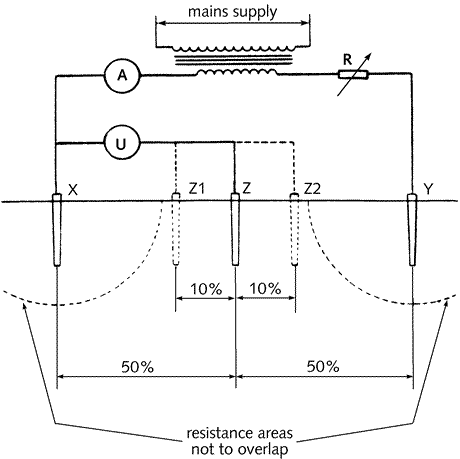- Joined
- 27 Jan 2008
- Messages
- 27,536
- Reaction score
- 3,328
- Location
- Llanfair Caereinion, Nr Welshpool
- Country

The point is we have in homes three earthing systems.
TN-C-S as you say switch on an electric fire and measure volt drop.
TN-S only real way is special meter.
TT combination of TN-C-S method plus measure earth rod.
OK TN-C-S measure the volts say 230 and then switch on electric fire 3kW and volts at 225.5 and the loop impedance is 0.35 ohms approx. But control is to take same time and measure voltage without plugging in electric fire and likely same variation.
As to TT well I have never tried to measure with anything but a meter designed for the job. But the first problem is needs to be AC or no current draw or ground will be polarised. Even with the proper meter the problem is getting enough area to put in the test probes.
The idea is two test probes are placed a set distance and half that set distance and the half way probe is moved a little closer and a little further away and readings should be the same. If not more distance is required.
I have never tried to work out what it does I am sure some form of Wheatstone Bridge to ensure no current. I would be interested to know who it does work. In real terms only when there is no power do we use that method normal is to use the DNO supply as a reference point.
With either TN system ELI is easy to find it involves a phone call so not worth worrying about but TT is very different. I am sure there is a way to measure with a multi-meter and I am all ears if some one can explain.
This link explains using proper meters but what about with a multi-meter. It is a good question there should be a way.
TN-C-S as you say switch on an electric fire and measure volt drop.
TN-S only real way is special meter.
TT combination of TN-C-S method plus measure earth rod.
OK TN-C-S measure the volts say 230 and then switch on electric fire 3kW and volts at 225.5 and the loop impedance is 0.35 ohms approx. But control is to take same time and measure voltage without plugging in electric fire and likely same variation.
As to TT well I have never tried to measure with anything but a meter designed for the job. But the first problem is needs to be AC or no current draw or ground will be polarised. Even with the proper meter the problem is getting enough area to put in the test probes.
The idea is two test probes are placed a set distance and half that set distance and the half way probe is moved a little closer and a little further away and readings should be the same. If not more distance is required.
I have never tried to work out what it does I am sure some form of Wheatstone Bridge to ensure no current. I would be interested to know who it does work. In real terms only when there is no power do we use that method normal is to use the DNO supply as a reference point.
With either TN system ELI is easy to find it involves a phone call so not worth worrying about but TT is very different. I am sure there is a way to measure with a multi-meter and I am all ears if some one can explain.
This link explains using proper meters but what about with a multi-meter. It is a good question there should be a way.


